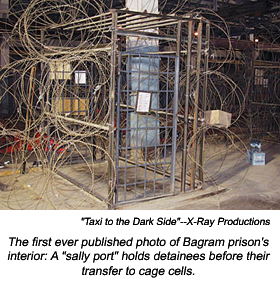Bagram Theater Internment Facility
 From Citizendium - Reading time: 4 min
From Citizendium - Reading time: 4 min
| This article may be deleted soon. | ||
|---|---|---|
The Bagram Threater Internment Facility is the most recent name for a American detention facility in Afghanistan, where prisoners are held in extrajudicial detention. There is a legal difference in using it for prisoners captured in Afghanistan, and for prisoners captured elsewhere; the former is accepted under military law, but the latter is being questioned. Its status, as a long-term detention facility under the Obama Administration is unclear. In February 2009, the Administration denied that prisoners there have habeas corpus rights, although this may have been a pro forma response to an inquiry from the U.S. District Court for the District of Columbia. Jack Balkin, a law professor at Yale, suggested the Administration might change policies, or "err on the side of doing things more like the Bush administration did, as opposed to really rethinking and reorienting everything”; it was simply too early to tell. “It may take some time before we see exactly what is going on — whether this is just a transitory policy or whether this is really their policy: ‘No to Guantánamo, but we can just create Guantánamo in some other place." [1] In April, the Administration appealed this decision, with the key distinction being made between prisoners captured in Afghanistan and those captured elsewhere. For the latter, the court rulings that applied to Guantanamo Bay detention camp may apply: prisoners in a facility considered under substantial U.S. control may have rights to request habeas corpus in Federal court. [2] New construction[edit]On May 16th, 2008, the George W. Bush Administration announced that it was planning to construct a new 40 acre detention facility to replace the temporary facility in the Soviet-era hangars.
This announcement was described as a reversal of earlier announcements that captives would be transferred from Bagram to Afghan custody.[4]The new facility is designed to hold 600 captives, or, over 1000 captives, on a temporary basis. Plans include spending $60 million from the Department of Defense's emergency funds, this fiscal year.[4] According to the New York Times the facility will be built around a "complex of 6 to 10 semi-permanent structures resembling Quonset huts, each the size of a football field" with out-buildings for "administration, medical care, and other purposes". The plans for the new facility include classrooms, and recreation areas — features missing from the current facility. The new facility would provide sufficient showers and sanitary facilities for all the captives — features deficient in the current facility. Due to its role as a Soviet hangar, the current facility is contaminated with heavy metals, and asbestos, and has been posing a health and safety risk for the captives and their guards.[4] According to Sandra L. Hodgkinson, Deputy Assistant Secretary of Defense, for Detainee Affairs"Our existing theater internment facility is deteriorating. It was renovated to do a temporary mission. There is a sense that this is the right time to build a new facility."[3] Physical site[edit]During the Soviet occupation of Afghanistan the Soviets built a large military airfield outside Bagram.[5] The airfield included large hangars that fell into disrepair when the Soviets were ousted. When the Americans and their local allies ousted the Taliban American forces took possession of the former Soviet base. The American's didn't need the volume of hangar space, so a detention facility was built inside large unused hangars.  A sally port at the Bagram Airfield During an interview on PBS, Chris Hogan, a former interrogator at Bagram, described the prisoner's cells in early 2002.[6] "I can't speak to what the conditions may be like now. But in my tenure, the prison population lived in an abandoned Soviet warehouse. The warehouse had a cement floor and it was a huge square-footage area," Hogan said. "On the floor of that, what must have been some sort of an airplane hangar, six prison cages were erected, which were divided by concertina wire ... Those prison cages had a wooden floor, a platform built above the cement floor of the hangar. Each prisoner had a bunch of blankets, a small mat, and in the back of each one of those cages, was a makeshift toilet, the same type of toilet that the soldiers used, which was a 50-gallon drum, halved with diesel fuel put in the bottom of it and a wooden kind of seat to that platform ... It's very similar, incidentally, to the conditions that the soldiers lived in; almost identical." Like the first facilities built at Guantanamo's Camp X-Ray, the cells were built of wire mesh. However only captives held in solitary confinement have a cell of their own.[7] The other captives share larger open cells with other captives. The sanitation was comparable to that provided to Allied troops. According to some accounts, although captives share these cells with dozens of other captives they are not allowed contact with one another.[7] Torture and prisoner abuse[edit]In December 2002, two captives died in custody. The U. S. Army Criminal Investigation Command, on October 14, 2004, sent, to the relevant commanders, findings that 28 soldiers may be culpable in the deaths.[8] Captives who have compared Bagram and Guantanamo have said that conditions were far worse in Bagram.[9] References[edit]
|
||
 KSF
KSF